This spring I drove down to the very southernmost tip of Texas, nearly to Brownsville to do a little night hunting with Armasight‘s new Contractor thermal scopes. Nighttime hunting is extremely popular in Texas for a few reasons, but regardless of why you’re doing it you’ll be well served by some quality night vision equipment.
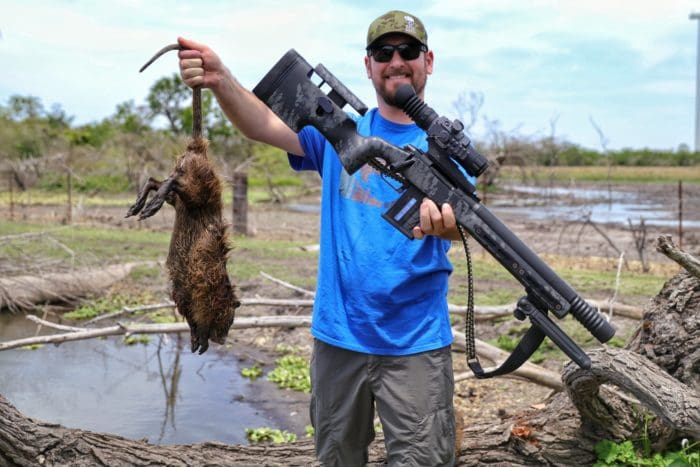
Texas is home to dozens of non-native / invasive / pest species of animals, which have different hunting regulations from game animals. While hunting at night is illegal for many or most animals in most states, Texas allows it under more circumstances for more animals during more of the year.
Given that nilgai, axis deer, hogs, coyotes, rabbits, and many other animals are practically nocturnal, being able to hunt them at night is huge. And not just with giant lights, but with night vision! This is why Texas is such a massive market for thermal optics and night vision optics sales.

As a natural location for testing out a new thermal rifle scope, then, Armasight invited some hunters down to a ranch in the southernmost part of TX. I drove down with a Black Collar Arms SBD in 375 Raptor and The Pig Truth .458 SOCOM AR-15 SBR.
The SBD received an Armasight Contractor 320 3-12x and The Pig Truth was kitted out with a Contractor 320 6-24x.

The Armasight team brought a few guns as well, and during that first night a feral cat got into the barn and peed all over one of them. Nearly all of us thought this was quite hilarious.
Can an Armasight Contractor handle cat urine? Yes. Its IP67 waterproof rating shrugged it off, though it did smell terrible.

Anyway, we spent a little time on the range the next day getting everything zeroed. A piece of aluminum foil or an actual target designed for thermal optics can be used to ensure a bullseye that stands out in temperature and/or reflected heat radiation from the rest of the target.
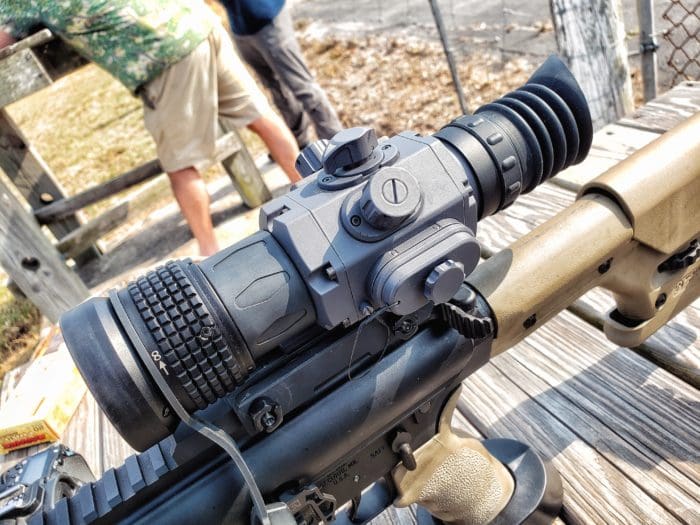
Zeroing the Contractors is a delightfully, amazingly quick and simple process! Like, crazy easy:
• If you and your rifle are accurate, fire a good shot and you’ll zero in that single shot. Otherwise, shoot a group.
• Click a button and a second reticle appears
• While holding the original reticle on the bullseye, rotate the control knobs to move the second reticle up/down/left/right until it’s on your bullet hole (or in the center of your group). Is your original reticle on the bullseye and your new reticle on the bullet hole? Click enter.
• Boom, done. The Contractor adjusts its screen and reticle and whatnot so the new reticle, which matches your point of impact, is now dead center in the screen and it becomes your only reticle.
And by “only reticle” I mean the only one you see on the screen when you’re using the thermal scope, of course. What I don’t mean is that the Contractor doesn’t give you options. There are eight-plus different reticle types and colors.
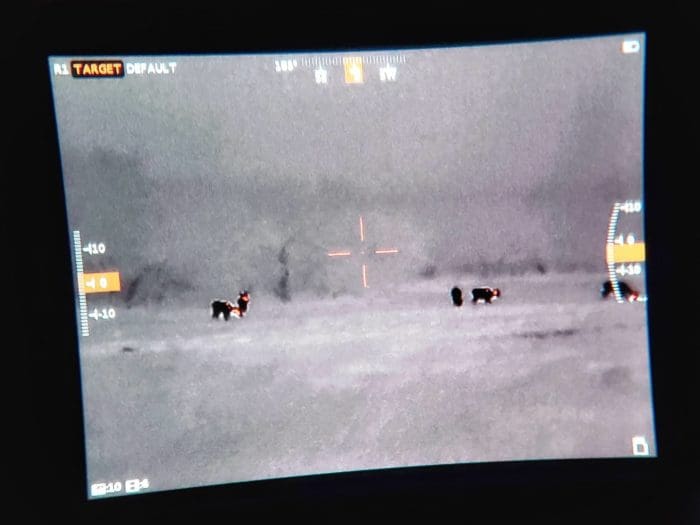
As with any thermal that I know of, what your eye is seeing inside of the scope is actually a digital display. The reticle, too, is made of digital pixels displayed on the display. Want it green? No problem. Want it a different shape and style? No problem. Change the brightness? No problem. Dozens of options.
Seen above is a cell phone photo I took just holding my phone up to the back of the Contractor. Not the best representation, but fairly realistic. I’m looking at some deer with the scope in “Target” mode.
Target mode is a black-hot mode (cold to hot = white to black) with a slight sepia tone (easier on the eyes if you’re looking at it for extended periods at night) that makes the hottest objects glow red. It really makes animals pop out!
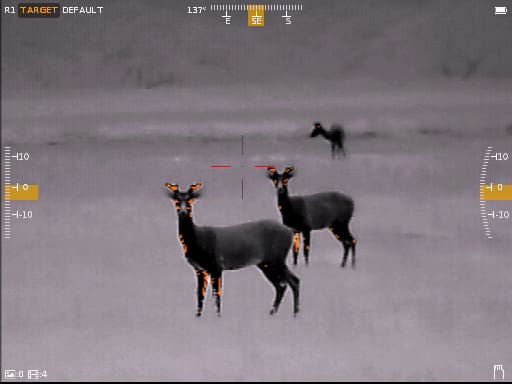
Captured through the Contract’s on-board image and video capture software, as seen above, the image is closer to what I actually saw with my eye; crisper with better contrast and definition. So, apologies…just out in the field with limited “after” time with the scopes it was better for me to get ’em on my own device immediately.
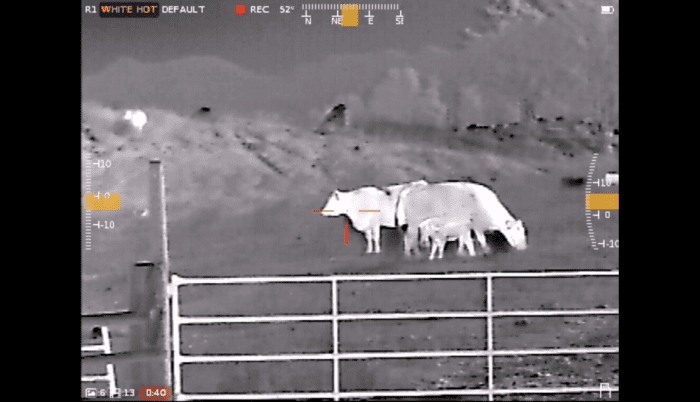
There are other color modes, of course, like white hot (opposite of black hot).
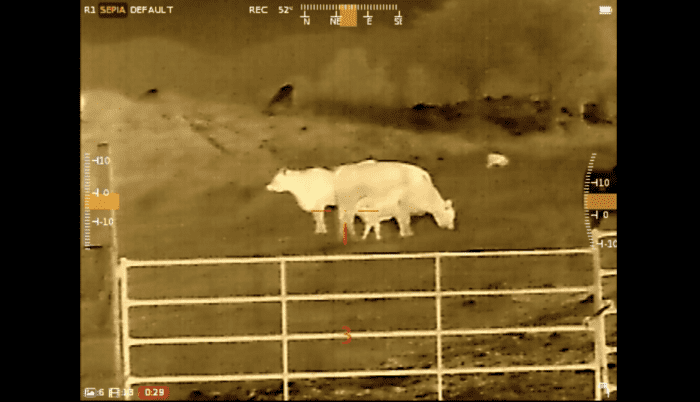
Sepia, which is white hot but made sepia (brown) for the easier-on-the-eyes reason mentioned previously. Things don’t pop as well, but if you’re doing a lot of scanning and stalking and observation, it’s definitely easier on the ol’ peepers.

There’s Rainbow. I didn’t get a great pic of this (obviously), but it’s kind of crazy and I’m honestly not sure when you’d use it outside of filming a Predator remake. While animals popped pretty hard, everything else was kind of psychedelic. Perhaps in an environment with more thermal variation than the very it’s-all-the-same-temperature tip of Texas it would make more sense. But it’s a lot.
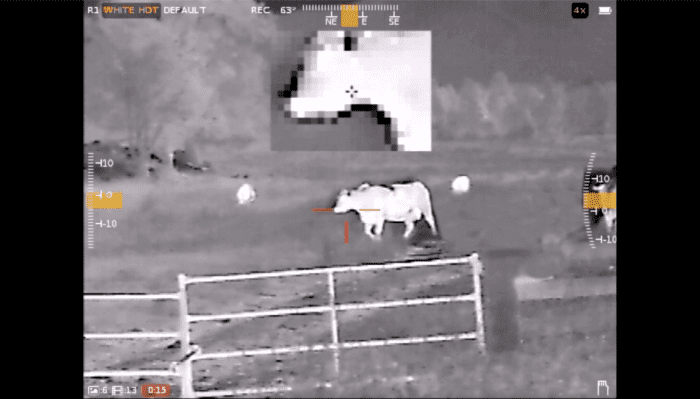
The Contractor thermal scopes have picture-in-picture capability, too. This provides a zoomed-in PIP with reticle at the top of your screen so you can take a precise shot but still have a full field of view going on in your main screen.
You can, of course, also zoom in via the full screen. 3-12x or 6-24x zoom, depending on model.

After getting all sighted in, we did a little daytime hunting with the thermals. I popped a big ol’ nutria!
While this can be difficult under the abusive Texas sun, where almost everything is the same temperature as a warm-blooded animal, the Contractor automatically adjusts to provide an appropriate amount of temperature range granularity, if that makes sense.
Whatever it’s lighting up as “hottest” and whatever it’s designating as “coldest” won’t be the same, basically, in different environments. If there’s only a couple degrees between hottest and coldest, it’ll show you a full range between those things and, therefore, provide a nice image with as much gradient as possible. If you’re in Target mode, it’ll still only put red highlights on the hottest X percent of objects inside the image (“X” because I don’t know what they’ve actually set as their threshold).
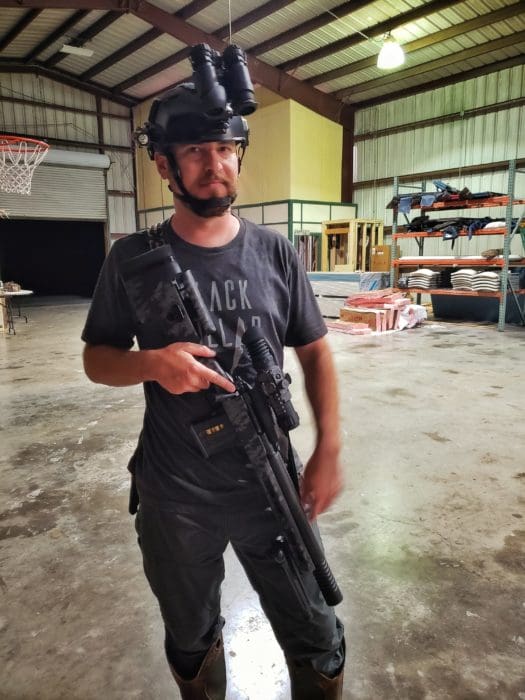
Naturally, though, this was a night mission, so night came and we set back out! First up we went for hogs, and there were hogs aplenty on this property.
We walked about a half mile down trails toward a pond, knowing hogs are typically there and working on staying downwind of the area on our way in. Armasight outfitted us with Team Wendy helmets equipped with Armasight BNVD Gen 3 night vision binos.
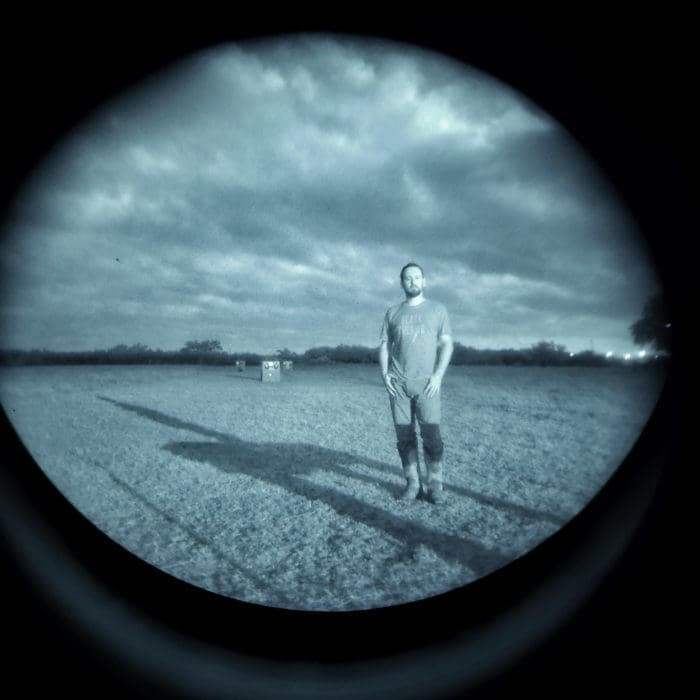
This was pretty cool, as the view under white phosphor night vision is pretty freakin’ good and it’s a different experience from thermal optics, since it’s actually amplifying available, visible light rather than “seeing” thermal radiation, AKA heat.
Eventually we got within about 120 yards of the pond and saw a handful of feral hogs milling around eating stuff.
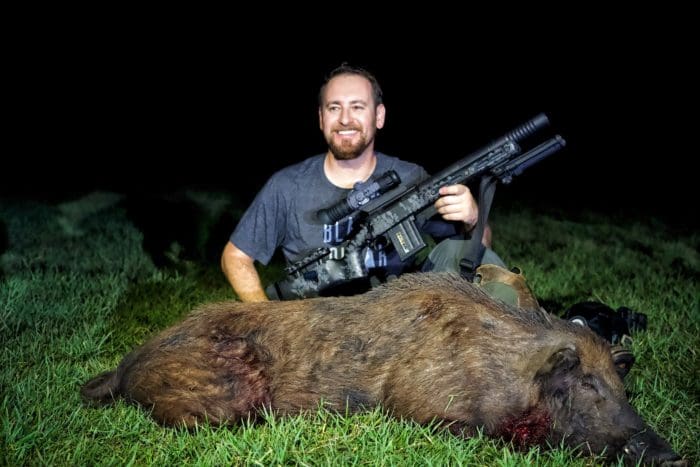
Hogs went down! The image in the Contractor is crisp enough to distinguish a hog from a javelina (something we discussed ahead of time to make sure no mistakes were made), which were also out there, and the reticle’s adjustable brightness and color made for easy, confident shots.

While most electro-optics have buttons, the Contractors primarily use two rotating knobs and a center knob/toggle. We all found this to be very user-friendly. These controls are easy to find, easy to adjust, and overall I felt faster and more confident manipulating them in the dark than I do when there are multiple buttons next to each other.
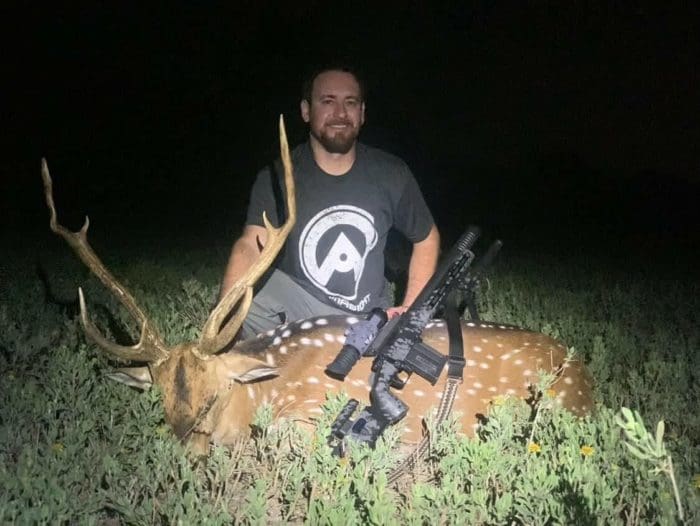
After posting up in a blind out in a field for a few hours, a nice axis buck strolled by. Though I had my hopes set on a nilgai on this hunt (and it was one or the other), time was running low and this buck looked really solid.
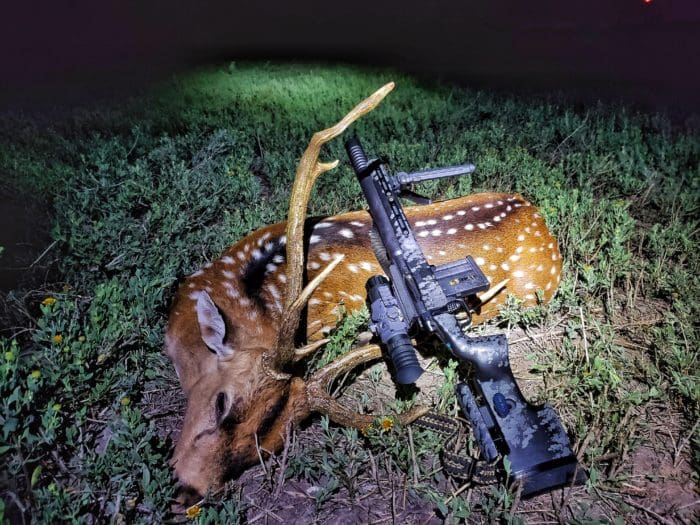
When he walked in front of other deer, I could see his antlers through the Contractor thermal in sort of a “relief” fashion, as they blocked the heat signature from the deer behind him. Many of the whitetail were in full velvet, and their antlers glowed bright red under the thermal, which was really cool to see, if a bit creepy.
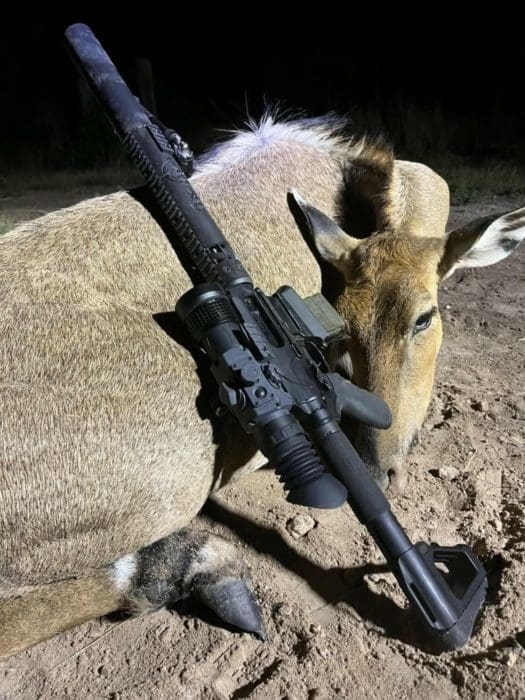
A writer for a different outlet borrowed The Pig Truth and, shooting the 500 grain solid copper expanding subsonic ammo I brought, put an absolutely flawless, perfect shot right through the chest of a big nilgai cow.
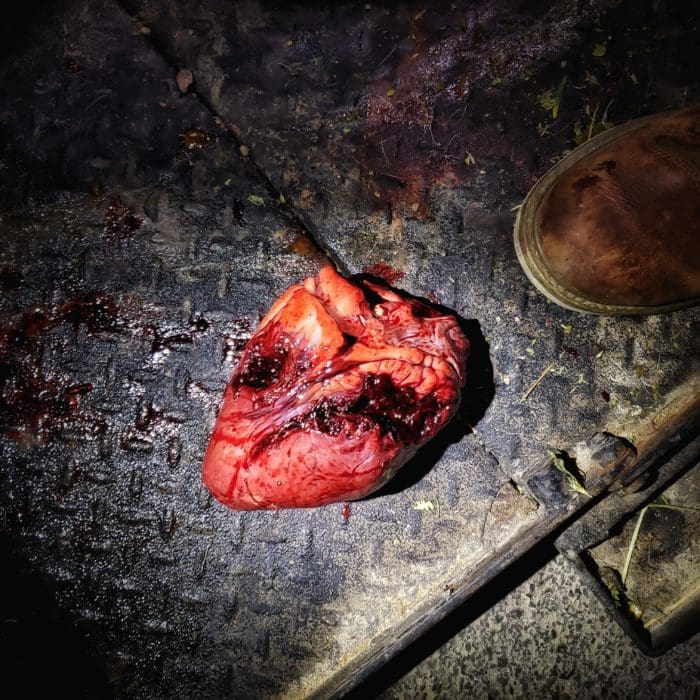
Right through her heart, in fact.
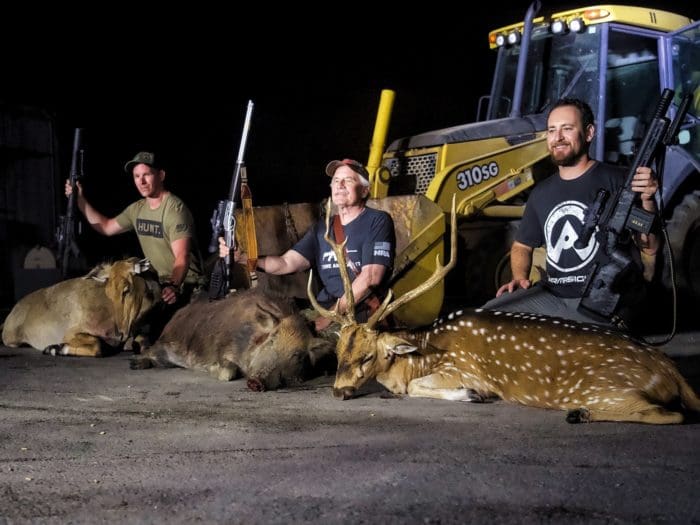
Not bad, right? In one night three of the largest non-native Texas animals were taken on the same property; a big wild hog, a nilgai, and an axis.
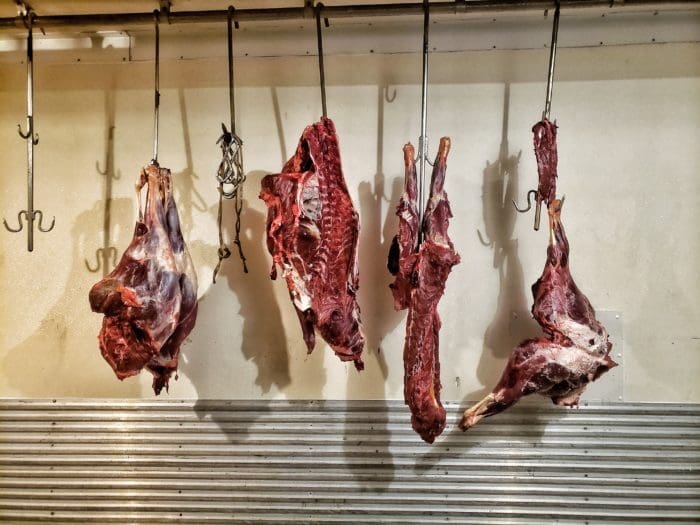
Now, this is what it’s really all about and, outside of simply eradicating hogs to prevent the billions of dollars of damage they do each year, this is why and how a thermal optic like the Armasight Contractor is worth $3,899 to $4,299 to a hunter.
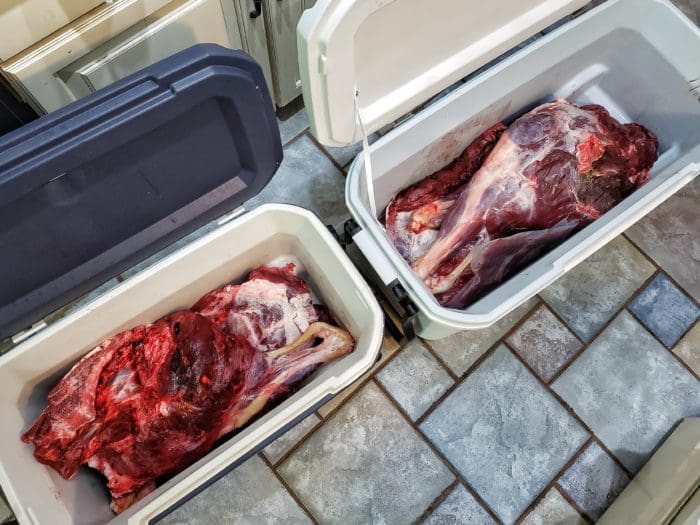
I gotta say, I really (really!) lucked out on this trip as I was the only local. I took home nearly all of the nilgai and all of the axis.
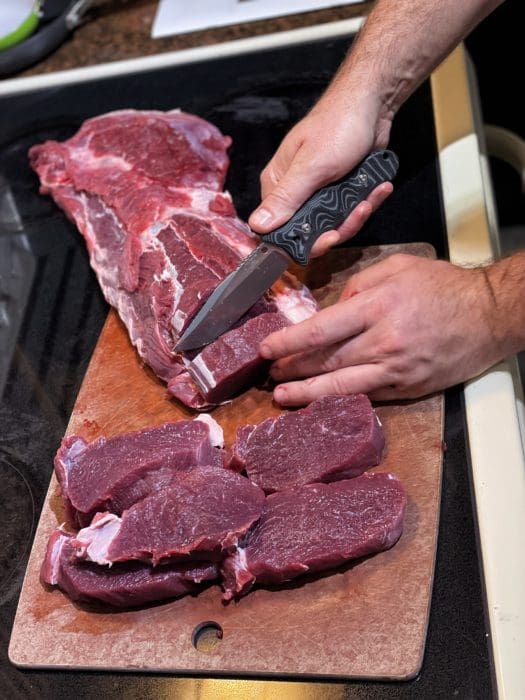
With my Hogue EX-F02 hunting knife and more than a little help from my lovely girlfriend, we broke down and vacuum sealed all of the axis and nilgai backstraps.
Get a load of the dark purple color of that axis! It’s pretty incredible.
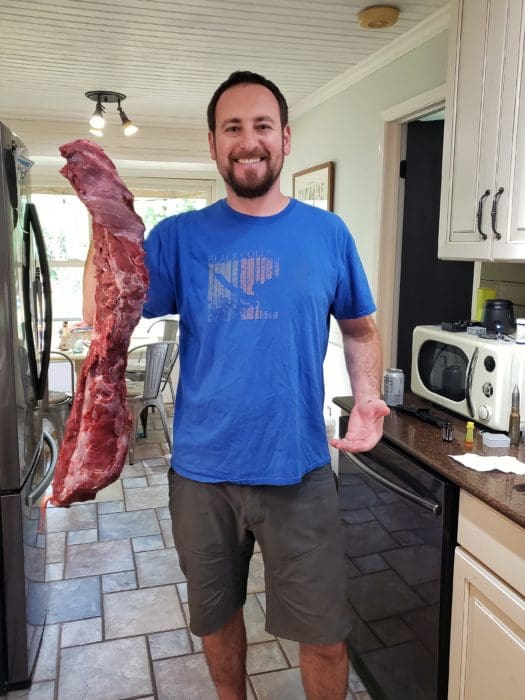
That, right there, is one of the axis backstraps. That was a big ol’ boy.
Axis deer is often rated as the best tasting wild game meat in the world. And, for sure, it’s dang good! It depends a bit on the specific deer, but it’s only mildly gamey and, cooked right, you could pass it off as an aged steak with most people.
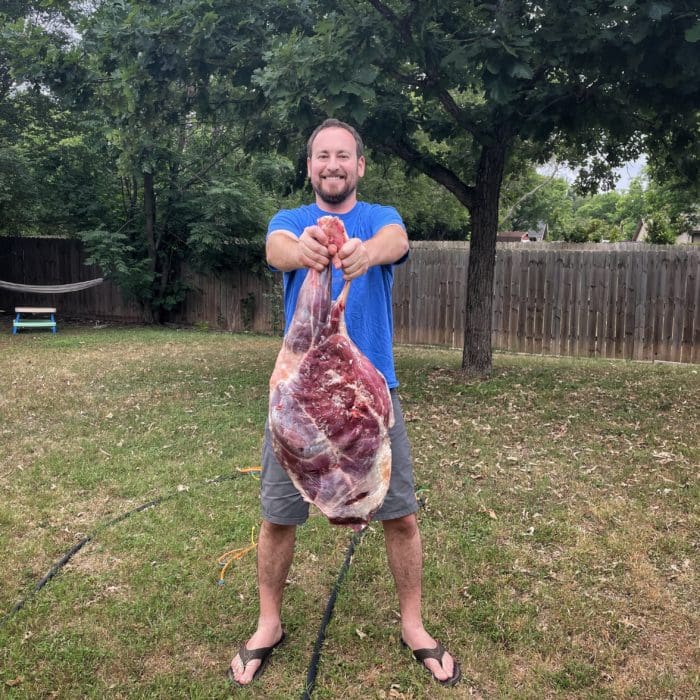
In my mind, though, anyone who thinks it’s the best hasn’t had nigai. It’s as good as any grass fed beef. It’s absolutely amazing.
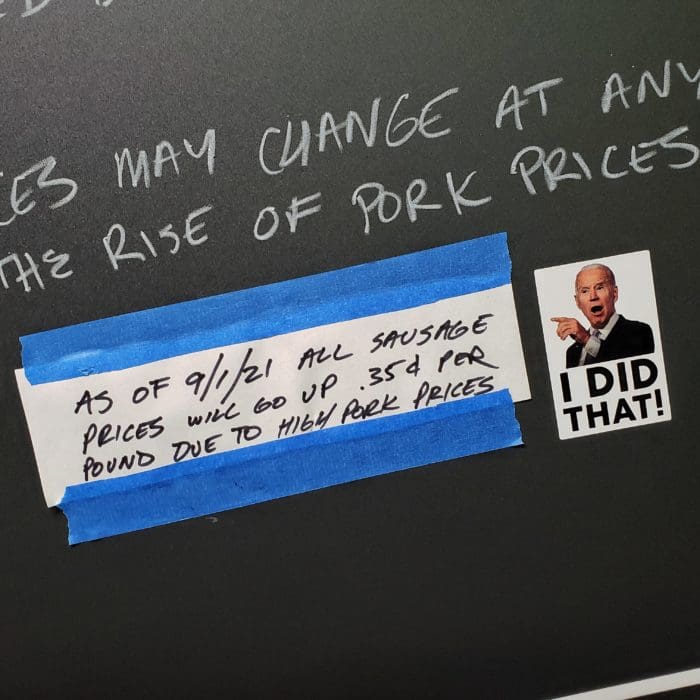
To help with everything that wasn’t a backstrap, I brought it all to Republic Butcher Company in Round Rock, TX. I wanted this meat straight — steaks and roasts, grinding only what’s truly too tough to eat as a solid piece of meat, no sausage or fajita meat or anything like that.
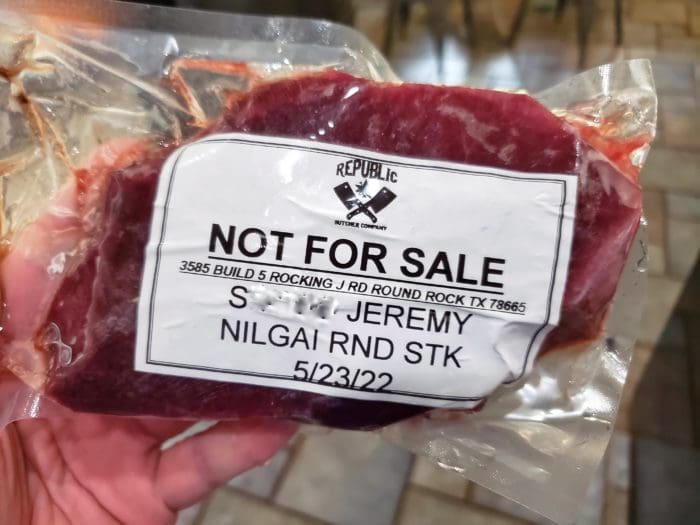
Matt at Republic broke it all down for me and individually vacuum bagged and labeled all of the cuts. Identifying and labeling the various cuts (sirloin steak, round steak, strip steak, etc.) is something I couldn’t have done myself.
He used 10% wagyu beef tallow in the ground meat and packaged the axis and nilgai separately into ~one-pound packs. I got 10 to 12 of those from each animal.
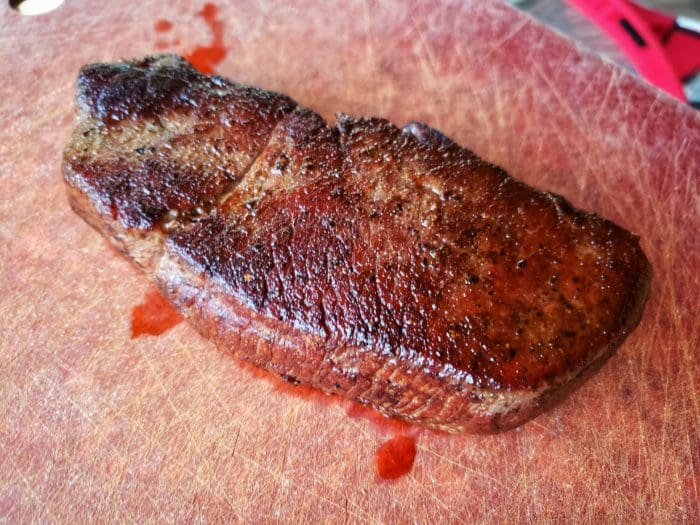
Yes.
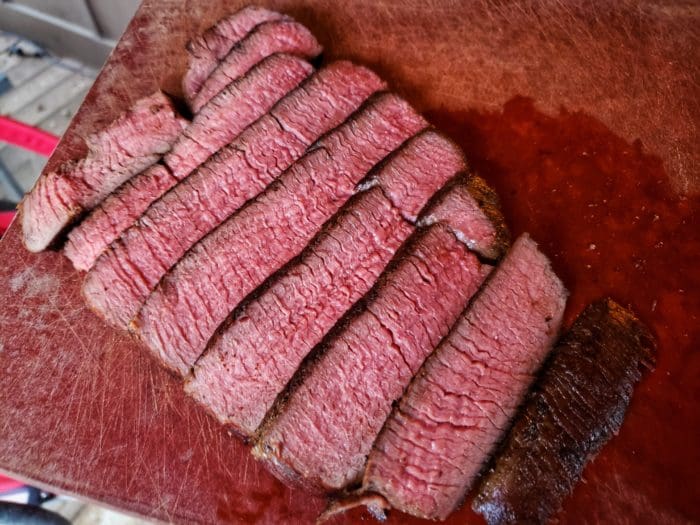
Yessss.
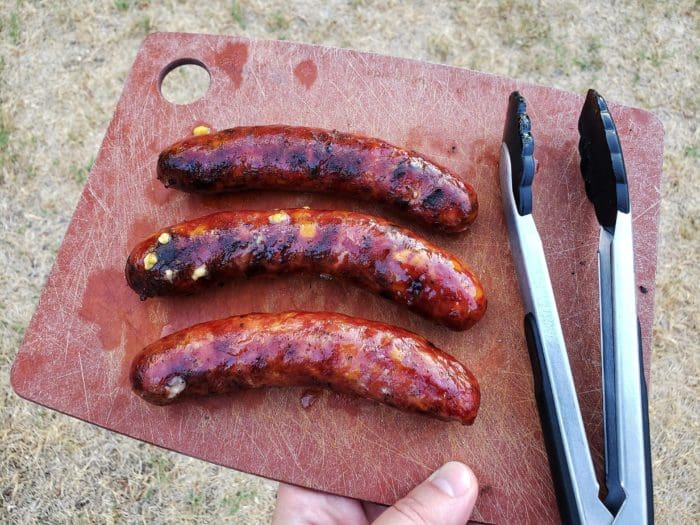
BUT…on my way out of his shop, Matt handed me a pack of jalapeño cheese sausages. He said it was his own recipe that he developed over five or six years and these were some bonus ones he had on-hand. He wasn’t entirely sure if it was wild hog or whitetail, but assured me they’re really good either way.
Well, I cooked ’em up and they were incredible. Like, huge fan. The girlfriend and my girls were, too. So I brought all of my ground axis back and had him make it into sausage.
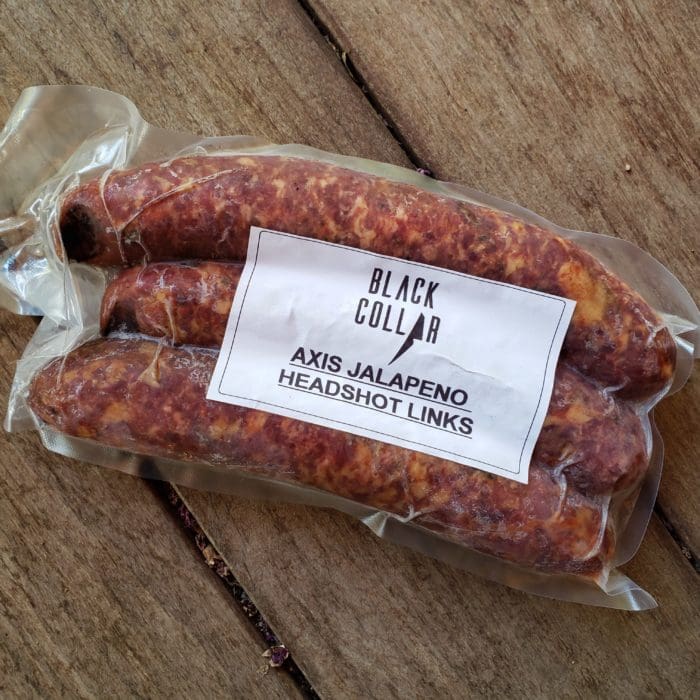
Turns out he has a sense of humor, too, as he surprised me with the logo borrowed off the Black Collar (which I co-own) website and a little fun in the text, too. Love it.

Ultimately, this is why thermal optics are awesome! It’s almost impossible to put a nilgai on the table and it’s significantly harder to bag an axis without the aid of night vision. Not to mention all the pest eradication that has to get done here in Texas.
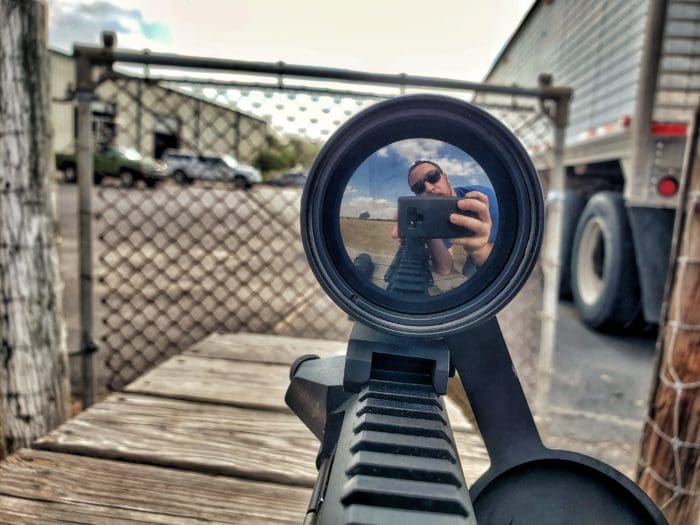
Armasight’s new Contractor models served all of us extremely well. At 320 resolution there are options with higher image definition, but coming in at a retail price under $4,000 was a big goal for Armasight and this was an important way to make that happen. Combined with good image processing software — I had zero issues, out to a couple hundred yards, recognizing a whitetail vs. an axis or a javelina vs a hog — and an extremely rich feature set, the Contractor overall is an extremely solid optic.
In particular, I was very pleased with the controls, menus, and zeroing process. These were some of the most user-friendly thermals I have ever played with. The menus and functions are simple to figure out, which is not always the case, and moving through, changing, and selecting from the various options is smooth and simple without wasted clicks.
Physically, the big knobs are great and I’ll take that over little buttons any day. It’s almost like they designed these things to be operated in the dark! Imagine that.
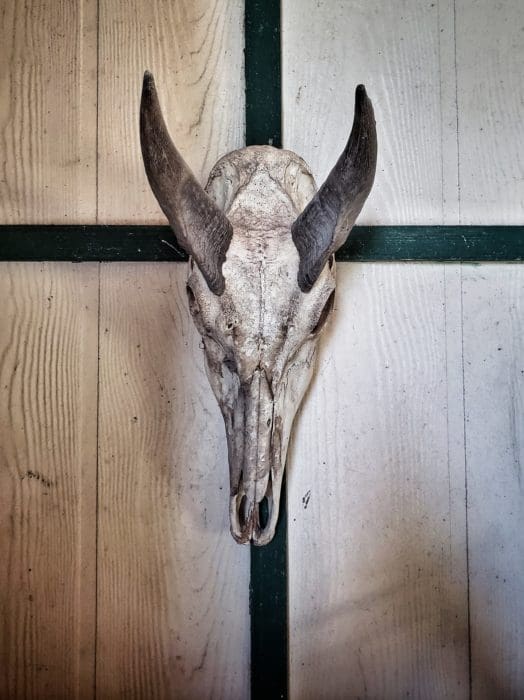
I still want to harvest a nilgai bull at some point, though! For filling the chest freezer with absolutely amazing, healthy (no hormones, no antibiotics, eating what it was made to eat), natural meat for sure. But also for a skull. The dang things look like the devil, and I want one on my wall with a light inside of it.
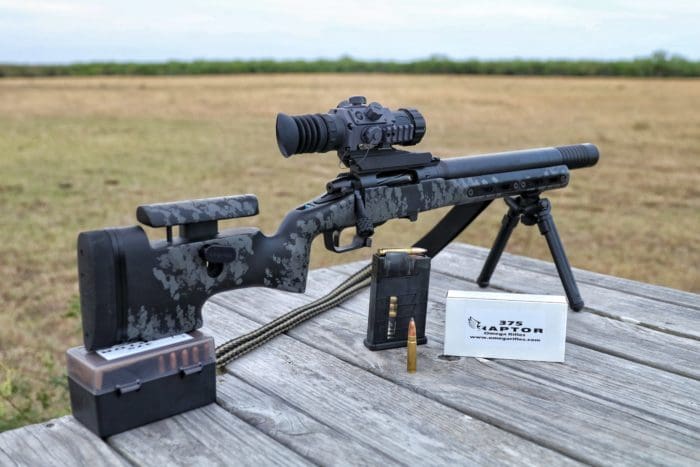
Great trip, great optics! Find out more about all of the thermal and night vision options at Armasight.com.

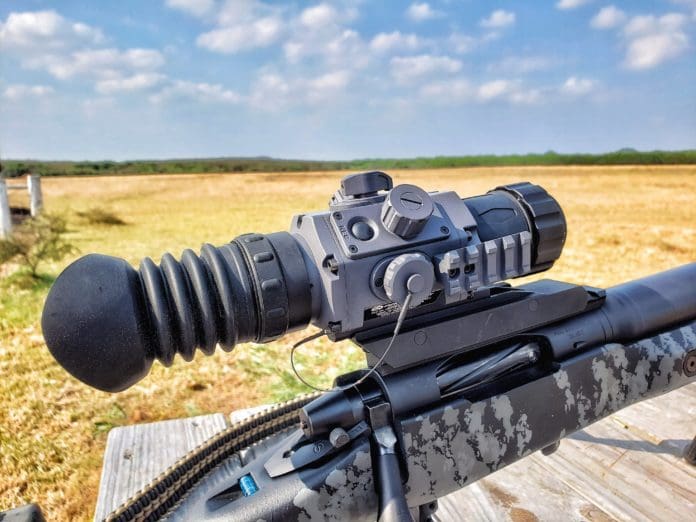



Mmmmm, Them steaks looked yummy !!! They would look even better on MY grill !
Hi Jeremy,
Great article about an exciting hunt.
I’ll be sure to enjoy more of your writing in the future,
except for the “gun meme” articles.
“I’ll be sure to enjoy more of your writing in the future,…”
If you click on Jeremy’s author link :
https://www.thetruthaboutguns.com/author/jeremy-s/
It will list his earlier articles…
LOL. Yeah, the Gun Memes definitely don’t count as “writing” haha. Or as “articles,” for that matter ;-). Unfortunately I don’t write as much as I used to, but I’m working toward changing that. I do enjoy it! That last article about the sheriff’s department auction really cracked me up and I enjoyed myself with that one haha
Thanks 🙂
Had to google nilgal!
It’s my understanding that South Texas (and a bit of northern Mexico) is the only place in the world where you can hunt them! Though they’re an antelope, they have similarities with cows and look a bit like them, so they’re considered sacred in their native India. They’re HUGE, diesel looking M’Fers. The bulls get to like 700-800 lbs I think and they’re all jacked like they take steroids haha
I live in Texas and go to the RGV somewhat often. I’d never seen nor heard of those things until reading this!
Thanks for the education and the writeup
“The Contractor adjusts its screen and reticle and whatnot so the new reticle, which matches your point of impact, is now dead center in the screen and it becomes your only reticle.”
Sorry if this is a dumb question, but since the reticle placement on the screen is a calculation, has anyone considered integrating a laser ranger finder with a thermal scope like that? Laser rangefinders have been steadily dropping in price.
It would open up some really cool possibilities, like a Bluetooth link from the scope over to an app on your phone that holds a database containing the shooter’s various cartridge loads and the bullet drops they have over distance to the target…
Not at all dumb. It exists! I think a few brands offer that. I think it’s fair to say that most nighttime hunting happens at more limited ranges than daylight hunting due to constraints on ensuring proper target ID and other stuff, so ballistic calculations are less commonly required. But on the flip side it’s also more difficult to visually estimate range, so an integrated rangefinder could be handy (even if it didn’t sync to a reticle that adjusts for elevation holds automatically).
Awesome article! More like this, please!
Oh .
Thermal.
If I want Thermal its gotta be able to lazer beam down satellites.
Man, several years down the road and the “Pig Truth” build and that awesome hand guard is still one of the coolest AR builds I’ve ever seen.
Jeremy, you daid that you were glad you can differentiate between pigs and javelena in the screen. Does Tx. have closed season on javelena (and peccary) now? It used to be a “drop em all”
hunt, didn’t it?
“Eventually we got within about 120 yards of the pond and saw a handful of feral hogs milling around eating stuff.”
The ‘Armasight Contractor Thermal Scope’ is a nice thing, no doubt about it. Its also very expensive.
For those that can’t afford a ‘Armasight Contractor Thermal Scope’ at $3,000.00 plus dollars for shots under 300 yards…to have something with things you can make up an excuse to use (not necessarily a bad thing if you can afford it or a company gives you one), just for hunting…
there are cheaper alternatives – for example, the SightMark Wraith product line (about 3 hour battery life but all in the line for under $800.00), Pulsar Digisight Ultra LRF N450 Digital Night Vision Rifle Scope (a lot of these in use by the Ukrainian military – about $1,400.00 but 8 hours of battery life) – both have video and audio recording also. The Sightmark is good to 300 yards, the Pulsar is good to 600 yards.
I’d have to go back a long way to find an article I enjoyed as much as this one. Well done¹, and thank you, Jeremy.
1. Only for the pork. Rare/medium rare for the rest, please.
https://www.youtube.com/watch?v=BMnVmHjKVsg
Would my Dream Thermal Cam for the moment white Full HD/60 FPS not only for rifle, for 360 degree cam in motorhome, cars, house security too but i heard 30000 dollar arround
Another cool item is the therm app pro hz with 640×480 / 30 fps but still arround 3500 dollar
https://www.youtube.com/watch?v=Jc_23WPdezk
And don t forget if your thermalcamera have 9 hz + you need an gouverment permit for any come in and going out with it outsidte the borders
Comments are closed.